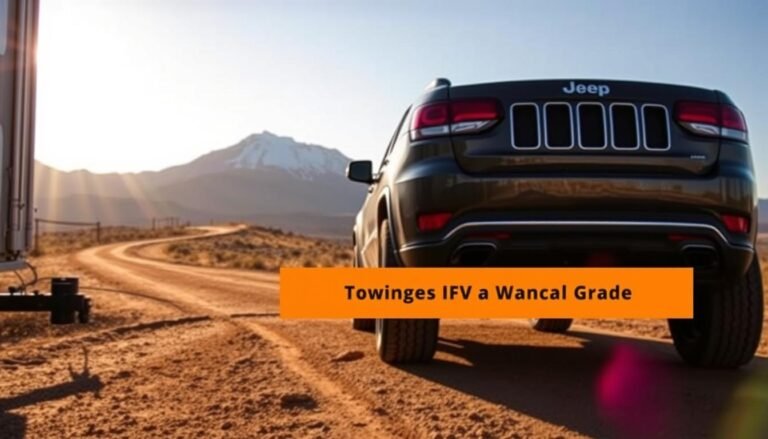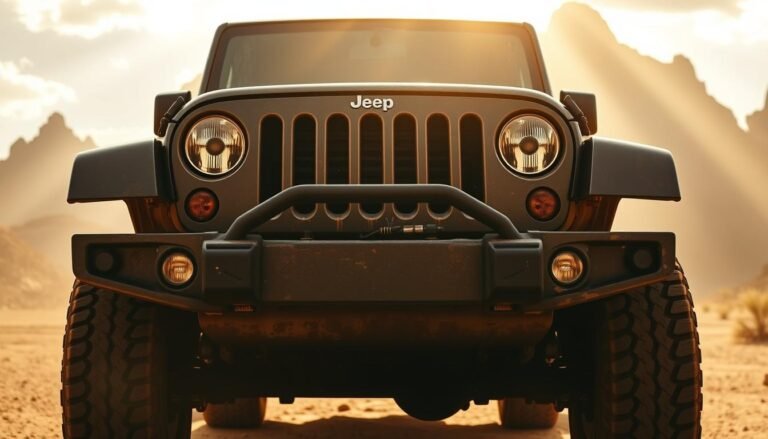Jeep Wrangler Maintenance Schedule Better Guide
What does a Jeep Wrangler maintenance schedule include? It’s all about important service times to keep your Jeep running great.
Whether you’re driving on the highway or off-road, regular upkeep is key. This guide will show you the essential services and when to do them to keep your Jeep in the best condition.
You’ll find out about all the service intervals next, from oil changes to making sure your tires are right.
By sticking with this schedule, your Jeep Wrangler will be ready for any adventure. Regular check-ups improve your ride and make your Jeep last longer.
Now, let’s get into the detailed plan for taking care of your Jeep Wrangler. This will help you stay on top of every important maintenance step.
What’s The Importance of Regular Maintenance?
Regular maintenance is key for your Jeep Wrangler’s longevity and performance. Keeping it up not only keeps it running well but also makes driving better.
By following a maintenance schedule, you avoid small problems turning into big repairs and unexpected troubles.
Why Maintenance Matters For Your Jeep Wrangler?
Your Jeep Wrangler is essential for everyday trips and off-road fun. Regular checks keep important systems like the engine, brakes, and suspension working well.
If you skip these, you might face lower performance and safety risks. Regular inspections help spot early signs of trouble.
Benefits of Following a Maintenance Schedule
Sticking to a maintenance schedule has lots of benefits, like:
- Improved fuel efficiency, saving you money over time.
- Better safety, protecting you and your passengers.
- Higher resale value, making your Jeep a good investment.
- Confidence that your Jeep is ready for any journey.
Having a good maintenance schedule makes your Jeep last longer and improves your driving experience.
Overview of The Jeep Wrangler Maintenance Schedule
It’s vital to follow a maintenance plan for your Jeep Wrangler’s health and efficiency.
Sticking to scheduled services helps avoid issues and maintains smooth operation. Here are some important tips for keeping your Jeep running great.
Key Service Intervals and Recommendations
The maintenance schedule for the Jeep Wrangler is based on mileage. It ensures key services like oil changes and tire rotations happen when needed.
Check out the table below for what to do at each milestone:
| Mileage | Recommended Services |
|---|---|
| 7,500 Miles | Oil change, tire rotation |
| 20,000 Miles | Brake inspection, replace A/C filter |
| 40,000 Miles | Change front and rear axle fluid |
| 60,000 Miles | Transfer case fluid change |
| 100,000 Miles | Inspect belts, replace PCV valve |
Keeping up with these service intervals means your Jeep Wrangler will always be ready for adventure.
This regular upkeep ensures your vehicle performs well under all conditions.
Jeep Wrangler Maintenance Schedule: Essential Services
Keeping up with routine maintenance helps your Jeep Wrangler run better for longer. Using a checklist makes sure your car stays in top shape.
We’ll look at oil changes and tire care, two key maintenance tasks.
Regular Oil Change Intervals
Changing your oil regularly is key to a healthy engine. Your Jeep Wrangler needs new oil every 7,500 miles or even sooner, depending on how you drive.
Clean oil boosts engine performance and life. Ignoring oil changes can cause big engine issues.
Always use your maintenance checklist to remember when it’s time for an oil change.
Tire Maintenance and Rotation Needs
Looking after your tires is crucial for good vehicle performance. You should rotate your tires every 7,500 miles to wear them evenly and handle better.
Check your tire pressure every month for the best grip and safety. If your tires wear unevenly or get damaged, they might need replacing.
Good tire care means your car will use less fuel and ride smoother, just like your checklist suggests.
| Service | Interval (miles) | Notes |
|---|---|---|
| Oil Change | 7,500 | More frequent if driving under severe conditions. |
| Tire Rotation | 7,500 | Check pressure monthly and look for wear. |
Frequency of Jeep Wrangler Service Intervals
Knowing when your Jeep Wrangler needs service is key. It keeps it running well and reliably.
Sticking to a jeep wrangler maintenance schedule stops problems before they start, keeping your Jeep in top shape.
What To Expect Every 7,500 Miles?
At 7,500 miles, your Jeep needs several important services. These help keep it healthy. They include:
- Oil change to keep the engine lubricated.
- Tire rotation to promote even tire wear.
- Inspection of the battery to avoid unexpected failures.
- Brake check to ensure optimal stopping power.
- Assessment of the coolant system for effective temperature regulation.
Services at 20,000 Miles and Beyond
Reaching 20,000 miles means adding more checks to your list. Important tasks at this point include:
- Replacing the A/C filter to maintain cabin air quality.
- Fluid level checks in the transfer case for smooth gear shifting.
- Thorough inspections of belts and hoses to catch wear early.
Staying ahead with your jeep wrangler maintenance schedule keeps your Jeep running well for years.

In-Depth Look at 7,500 Mile Service
When your Jeep Wrangler hits 7,500 miles, it’s time for a serious check-up. This service is the first big step in caring for your ride.
It helps keep your vehicle running smoothly for years. The jeep wrangler maintenance guide highlights the need for an oil change and checking other systems.
Details of Oil Change and Related Services
Changing the oil is key at this service. New oil makes your engine work better and lasts longer. You should also look at other fluids, including:
- Coolant
- Brake fluid
- Transmission fluid
Each fluid is crucial for your Jeep’s performance. Skipping these checks could cause big problems.
Inspecting and Maintaining Tire Health
Taking care of your tires is just as important. Checking the tread and keeping the right tire pressure are vital.
These steps prevent accidents and save gas. Issues with uneven wear might mean your tires need alignment.
To keep your tires in top shape, remember to:
- Check tire tread depth
- Inspect for uneven wear patterns
- Maintain proper tire pressure
This maintenance guide helps boost your Jeep’s performance. Early care is crucial for a smooth and safe ride.
Don’t skip these maintenance tasks to ensure your Jeep’s health and reliability.
20,000 Mile Service: What to Check?
When your Jeep Wrangler hits 20,000 miles, it’s time for a check-up. You’ll need to do more than just oil changes and tire rotations.
It’s key to inspect specific parts to keep everything running right. Staying on top of these checks helps dodge future problems.
Replacing the A/C Filter and Checking Fluids
Begin by swapping out the A/C filter. A fresh filter improves the air you breathe inside and keeps cooling effective.
Then, make sure to check the levels of all your fluids. This includes coolant, brake fluid, and transmission fluid.
If they’re low, it could mean you have leaks or need a fluid change. These steps are vital for keeping your Jeep in top shape.
Brakes and Suspension Inspection at 20k
Give your brakes a thorough check at this milestone. This means looking at the brake lining, brakes, and how well the parking brake works.
Safety is paramount. Also, examine the suspension parts, like tie rods and CV joints. Catching signs of wear early can save you from expensive fixes later on.

40,000 Mile Service Recap
Your Jeep Wrangler needs important maintenance at the 40,000-mile mark. It’s crucial to follow the jeep wrangler maintenance schedule then. This includes changing fluids and checking important parts.
Fluid Changes for Long Lasting Performance
Changing fluids at 40,000 miles is important, especially in the axles. If towing or off-roading was part of your Jeep’s life, prioritizing this is key. These new fluids help your Jeep run smoothly and efficiently.
Assessing Wear and Tear of Critical Components
It’s time to check the brakes and suspension. These may wear down from tough driving. Regular checks catch problems early, keeping your Jeep in top condition.
60,000 Mile Maintenance Insights
At 60,000 miles, your Jeep Wrangler hits an important mark. It’s time for maintenance that keeps it running well.
This point reminds us to check the transmission and transfer case. These are essential for the Jeep’s reliability, especially for towing or off-roading.
Importance of Transmission and Transfer Case Services
At this service time, changing the transmission fluid and checking the transfer case fluid is key.
The transmission is crucial to your Jeep’s power. Here’s what you need to know:
- Transmission Fluid Change: Fresh fluid keeps things cool and shifts smooth.
- Transfer Case Service: Clean fluid improves off-road and towing abilities.
Ongoing Care For Off-Road and Towing Use
Using your Jeep Wrangler for off-roading or towing means extra care is needed. Some tips include checking:
- Differential fluids to avoid wear.
- Brake parts to ensure they’re reliable when it’s tough.
- Hoses and belts for any cracks or wear.
By following a detailed jeep wrangler maintenance plan, you keep your vehicle tough and efficient. This gives you a reliable and smooth ride, no matter where you go.

100,000 Mile Maintenance Considerations
When your Jeep Wrangler hits the 100,000-mile mark, it’s a major moment. Taking proper care at this time keeps it running well for longer.
It’s key to follow the maintenance checklist, especially checking important parts.
Inspecting Belts and PCV Valve Replacement
At this point, checking the drive belts is critical. These belts wear out after lots of use. Look for cracks, fraying, or damage to prevent problems.
If they’re worn, replacing them is a must for your Jeep to run smoothly. Also, don’t forget about the Positive Crankcase Ventilation (PCV) valve.
It helps your engine work better by managing gas flow. A new PCV valve can make your Jeep emit less pollution and use fuel more efficiently, both important for an older vehicle.
Long-Term Maintenance Tips For Jeep Owners
Keeping your Jeep in top shape goes beyond quick fixes. Think about how you drive, especially if you like going off-road.
Your maintenance checklist might need updates for tougher driving conditions. This should include checks on:
- Fluids: Keep an eye on engine oil, coolant, and transmission fluid levels.
- Tires: Check regularly for wear, pressure, and alignment to avoid trouble.
- Brakes: Make sure brake pads and rotors are in good shape for safety.
Staying ahead with maintenance will help your Jeep last past 100,000 miles, giving you many more years of adventure.
Jeep Wrangler Maintenance Tips For Longevity
It’s important to follow reliable maintenance tips to keep your Jeep Wrangler running smoothly.
Doing regular DIY maintenance saves money and feels rewarding. It also helps your vehicle stay in top shape for longer.
Best Practices For DIY Maintenance
Checking your Jeep’s parts often can make it last longer. Consider these tips:
- Inspect fluids regularly such as engine oil, coolant, and brake fluid.
- Check tire pressure and tread depth to ensure safety and efficiency.
- Examine brake pads and rotors for wear, replacing them as needed.
- Clean and maintain the battery terminals to prevent corrosion.
- Rotate tires every 5,000 to 7,500 miles for even wear.
When to Seek Professional Servicing
DIY maintenance is great for simple tasks, but sometimes you need an expert. If you’re unsure about a repair, see a specialist.
Jeep workshops offer top-quality service for your vehicle’s specific needs. Professional mechanics can also do thorough diagnostics and repairs, which gives you confidence in your jeep wrangler regular service.

Common Issues To Watch For in Jeep Wrangler Servicing
Keeping your Jeep Wrangler in top shape means being alert to problems before they grow bigger.
Staying ahead of wear and tear helps your car last longer and keeps repair costs down. Getting your Jeep checked regularly spots small issues before they become big worries.
Identifying Signs of Wear and Tear
Look out for these signs that your Jeep Wrangler might need a check-up:
- Unusual noises while driving, such as grinding or clunking sounds.
- Fluid leaks under the vehicle, particularly oil or transmission fluid.
- Inconsistent braking performance or squeaky brakes.
- Uneven tire wear suggesting alignment or suspension issues.
Addressing Potential Major Repairs Early
Fixing problems early can save you a lot of money. Here’s what you can do:
- Regularly check your tires and fluid levels.
- Don’t ignore dashboard warning lights; deal with them quickly.
- Get a professional to look at any strange noises.
- Keep up with the recommended Jeep servicing schedule to prevent issues.
By following these steps, your Jeep Wrangler will always be ready for adventure. Plus, you’ll prevent damage that could have been avoided.
Conclusion
Keeping up with a strict jeep wrangler maintenance plan is key to keeping your vehicle’s performance and adaptability.
Regular check-ups, from basic oil changes to detailed inspections, greatly improve reliability and extend your Jeep’s life.
Following this jeep wrangler maintenance guide ensures your vehicle stays in top shape.
Remember, taking care of your Jeep before problems pop up saves you money. Timely services and part replacements can prevent big repairs later.
A regular maintenance schedule safeguards your investment and enhances your adventures on and off the road.
Staying true to a regular maintenance schedule keeps your Jeep Wrangler adventure-ready and reliable for day-to-day use.
By keeping up with maintenance, you’ll enjoy your Jeep to the fullest and keep it running smoothly.
FAQs
Q: What is the recommended maintenance schedule for my Jeep Wrangler?
A: Keep your Jeep Wrangler in top shape by getting oil changes every 7,500 miles. Also, rotate the tires at the same interval. For brakes, check them at 20,000 miles. Change key fluids at 40,000 and 60,000 miles.
Q: How can I determine if my Jeep Wrangler needs maintenance?
A: Watch for odd noises, leaks, tire wear, and dashboard alerts. Checking oil, coolant, and tire pressure will reveal if service is needed.
Q: What is included in the 60,000-mile service for the Jeep Wrangler?
A: At 60,000 miles, change your Jeep’s transmission and transfer case fluids. It’s vital for vehicles used in towing or off-road activities.
Q: How often should I rotate my tires?
A: Rotate your tires every 7,500 miles. This prevents uneven wear. Regular rotations increase tire life and make driving smoother.
Q: Why is it important to maintain my Jeep Wrangler?
A: Maintenance boosts safety and fuel efficiency. It also increases the Jeep’s resale value and extends its life. Staying on top of maintenance avoids big repair bills later.
Q: What should I check during routine maintenance at home?
A: At home, check your engine oil, coolant, and tire pressures. Look at tire tread, brake condition, and for any leaks. Early detection of issues can save you from bigger problems.
Q: When should I seek professional servicing for my Jeep Wrangler?
A: Go to a pro for big problems, major repairs, or if you’re unsure about a maintenance task. Experts offer the right skills for Jeep care.







